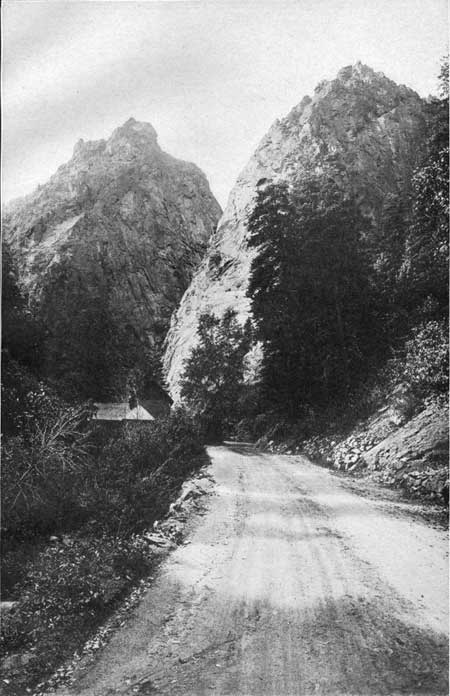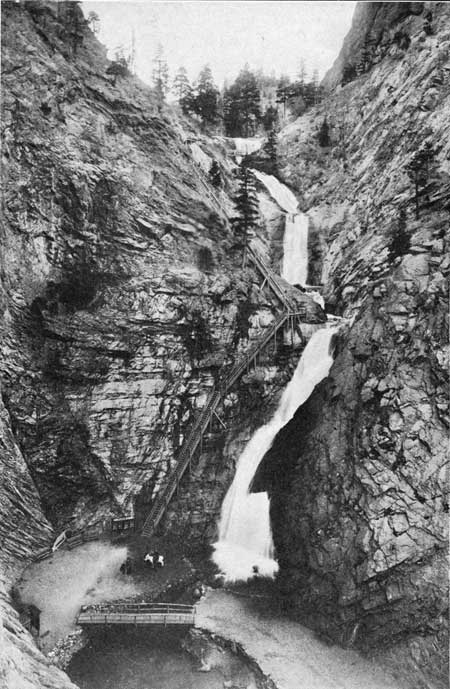
|
Geological Survey Bulletin 707
Guidebook of the Western United States: Part E. The Denver & Rio Grande Western Route |
ONE-DAY TRIPS FROM COLORADO SPRINGS.
(continued)
SOUTH CHEYENNE CANYON.
One of the most romantic as well as most beautiful places in the region about Colorado Springs is South Cheyenne Canyon, immortalized by Helen Hunt Jackson and for some years the resting place of her body.
This beautiful canyon lies 3 miles southwest of Colorado Springs and can easily be reached by trolley or private conveyance. The canyon (see Pl. XXIX) is attractive not only on account of the beauty of its magnificent granite walls—a miniature Yosemite—but also because the cut in the massive granite is the enduring record of events that took place long before the white man saw this country and in all probability before man existed on the globe. All the mountains, hills, valleys, and plains constitute records of similar events, but here the record is so clear and distinct that anyone may decipher it after he has had a slight training in the alphabet Nature uses.

|
| PLATE XXIX. PILLARS OF HERCULES. South Cheyenne Canyon is a miniature Yosemite with massive granite walls rising in a height of 700 or 800 feet. This view shows the road leading up to the Seven Falls and to the original grave of Helen Hunt Jackson. Here and there the rocky walls are relieved by the soft foliage of trees that grow in clefts in the rocks, and the rippling stream wanders along beneath a tangle of shrubs and creeping vines. Photograph furnished by the Cheyenne Canyon & Seven Falls Development Co. |
South Cheyenne Canyon and the form of the mountains in this part of the State indicate to the geologist, as already explained, that at a time long, long ago this part of the earth's crust was much nearer sea level than it is now. The mountains of Colorado were not then the magnificent spectacles they are to-day but were more like the Appalachians. Pikes Peak of that time was probably not more than 5,000 or 6,000 feet above sea level, and the plains reached back many miles into what is now the heart of the mountains, with isolated low ranges here and there projecting above their even surface. Then came a great uplift which finally raised the mountains to their present positions. On this uplifted mass of rock the streams, on account of their increased slope, were very active and at once began to cut deep trenches; these in time were widened where the rocks were soft, and finally all the higher land on the plains was cut away, but in the hard rocks of the mountains the streams have succeeded in cutting back only a short distance and have formed canyons like that of South Cheyenne. At some places in South Cheyenne Canyon this backward cutting has proceeded rapidly because the granite is shattered, but at the Seven Falls the joints and fissures in the rock extend to one side, as shown in Plate XXX, whereas the stream tumbles over a wall of the most massive rock imaginable, and the canyon ends so abruptly that it seems almost as if it had been the work of man. If the rock were not of this character the stream would probably have cut considerably farther back, and in that event the Seven Falls would probably have been replaced by a series of cascades. In time this cutting will doubtless be accomplished, for the stream is always at work—it knows no cessation from its labors—and, although the work of cutting the granite is extremely slow when compared with human standards, it is continuous, and if conditions remain the same as they are to-day the canyon will be cut far back into the mountain, until, in even more remote time, the mountains themselves may be worn down and a plain may be found where now we have our grandest scenery. The regularity and smoothness of the walls of South Cheyenne Canyon are due largely to the massiveness of the granite in which the canyon is carved.

|
| PLATE XXX. SEVEN FALLS. South Cheyenne Canyon ends abruptly at the Seven Falls, as shown in this view. The reason for the deep cutting up to this point is the presence of a zone of crushed rock, which is shown on the left. The stream comes in from another direction where the granite is massive and has made little headway in cutting a canyon. Eventually it will wear away the hard granite, and then the Seven Falls will become a series of cascades or rapids. Photograph furnished by the Cheyenne Canyon & Seven Falls Development Co. |
The traveler should climb to the top of the falls, where he can obtain a much better idea of the magnitude of the gorge, and then he will doubtless be impelled to climb still higher, to Inspiration Point, which is said to be the spot most beloved by Helen Hunt Jackson, the place where she wrote many of her most noted works of fiction. One can hardly imagine a more inspiring sight than that of Colorado Springs and the broad stretch of plain seen from this point; and here, amid the grandeur of the mountains, the romantic imagination of so ardent a lover of nature would readily be quickened into new life. She pays this tribute to Inspiration Point:
Beautiful cradle of peace! There are some spots on earth which seem to have a strong personality about them—a charm and a spell far beyond anything which mere material nature, however lovely, can exert; a charm which charms like the beauty of a human face; and a spell which lasts like the bond of a human relation. In such spots we can live alone without being lonely. We go away from them with the same sort of sorrow with which we part from friends, and we recall their looks with the yearning tenderness with which we look on the photographs of beloved absent faces.
Although Helen Hunt Jackson died in California, her last request was that her body be brought back and laid to rest in this spot on Cheyenne Mountain that she so dearly loved and that the place be marked only by the boulders which nature had provided. This was done, and many thousand travelers still visit the grave annually and pay tribute to the gifted author, though her body now lies in Evergreen Cemetery, Colorado Springs.
If the traveler returns from the canyon late in the afternoon he may see some of the beauty of the plains as it appeared to her poetic imagination:
Between the pines and the firs are wonderful vistas of the radiant plain. Each glimpse is a picture in itself—now an open space of clear sunny distance; now a belt of cottonwood trees making a dark-green oasis in the yellow distance; now the majestic bluffs, looking still more castle-like, framed in the dark foreground lines of pine boughs. We are in shadow. The sun has set for us; but it is yet early afternoon on the plain and it is brilliant with sun. * * * The brilliance slowly fades, and the lower sunset light casts soft shadows on every mound and hill and hollow. The whole plain seems dimpling with shadows; each instant they deepen and move eastward; first revealing and then slowly hiding each rise and fall in the vast surface. Away in the east, sharply against the sky, lines of rocky bluffs gleam white as city walls; close at the base of the mountain the foothills seem multiplied and transfigured into countless velvet mounds. The horizon line seems to curve more and more, as if somehow the twilight were folding the world up for the night, and we were on some outside shore watching it.
| <<< Previous | <<< Contents >>> | Next >>> |
bul/707/trip2c.htm
Last Updated: 16-Feb-2007